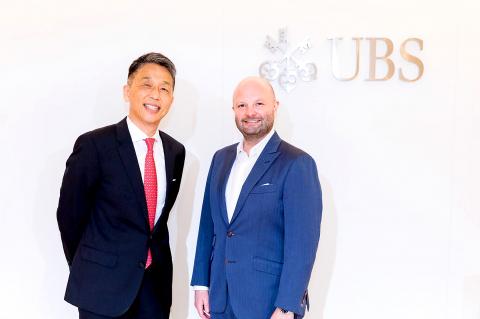Over the past few months, there has been much buzz around town about a possible new art fair in Taipei. Yesterday, the rumors were laid to rest by veteran art fair director Magnus Renfrew at a press conference held at Humble House in downtown Taipei. In partnership with the financial services company UBS Group AG, Renfrew and his team jointly announced the unveiling of Taipei Dangdai (台北當代), an art fair that will debut in January of next year at the Nangang Exhibition Center.
Renfrew, the fair’s director, is a seasoned player in the Asian art market and former director of Hong Kong’s first international art fair, Art HK, which was acquired by Art Basel in 2011, and continued his directorship of the fair until 2014.
The veteran art director sees great potential in Taiwan’s art market.

Photo Courtesy of Taipei Dangdai
“Taipei has ... a long established gallery scene, a extensive community of collectors, a vibrant cultural scene and the pure fact that Taipei is great place to visit,” Renfrew says.
While Art Basel Hong Kong has established itself as the international art fair in the Asian region, Dangdai will be defined differently by garnering its strength from a more regional market niche.
“There is a big gap between Art Basel Hong Kong and other fairs in the region, in terms of quality and how they are progressing. It’s necessary to have other fairs that have real quality and don’t necessarily aspire to be the global fair for the region,” Renfrew told Artnews.
The first edition of Taipei Dangdai will bring together 80 galleries from Taiwan, Asia and the rest of the world. The show will present a range of established and young galleries in four exhibition sectors, including a main gallery sector for leading galleries; a young arts sector for galleries of 8 years or less; a solo sector for single artist presentations; and a affordable art section for artworks valued at US$8,000 or less.
A series of talks will take place during the fair to build greater connection between art and other fields of knowledge including archaeology, urban planning, science and technology. Further details will be released this autumn.
Renfrew envisions Taipei Dangdai as a quality regional art fair that “adheres to global standards of practice in terms of selectivity.”
To ensure an objective selection process and avoid domestic politics, the fair has put together a selection committee of non-Taiwanese art professionals who have extensive knowledge of the Asian art market. The committee will be in charge of selecting participating galleries for the fair.
“We wanted to find gallerists with a strong understanding of Asia, and the ability to put the work of Asia in a global context,” Renfrew says.
Dennis Chen (陳允懋), head of UBS Taiwan, says Taipei Dangdai should elevate Taipei’s already burgeoning art market.
“Taipei Dangdai ... has immense potential for the development of the local art market and Taipei’s cultural ecology. The growth in the number of art collectors in Taiwan over the past 10 years has been matched by the quality of local connoisseurship,” Chen says.
In addition to financial sponsorship, UBS will be contributing to the fair program with a series of engaging activities for their clients, employees and the public. They are also planning educational events catered to a younger audience.

In Taiwan there are two economies: the shiny high tech export economy epitomized by Taiwan Semiconductor Manufacturing Co (TSMC, 台積電) and its outsized effect on global supply chains, and the domestic economy, driven by construction and powered by flows of gravel, sand and government contracts. The latter supports the former: we can have an economy without TSMC, but we can’t have one without construction. The labor shortage has heavily impacted public construction in Taiwan. For example, the first phase of the MRT Wanda Line in Taipei, originally slated for next year, has been pushed back to 2027. The government

July 22 to July 28 The Love River’s (愛河) four-decade run as the host of Kaohsiung’s annual dragon boat races came to an abrupt end in 1971 — the once pristine waterway had become too polluted. The 1970 event was infamous for the putrid stench permeating the air, exacerbated by contestants splashing water and sludge onto the shore and even the onlookers. The relocation of the festivities officially marked the “death” of the river, whose condition had rapidly deteriorated during the previous decade. The myriad factories upstream were only partly to blame; as Kaohsiung’s population boomed in the 1960s, all household

Allegations of corruption against three heavyweight politicians from the three major parties are big in the news now. On Wednesday, prosecutors indicted Hsinchu County Commissioner Yang Wen-ke (楊文科) of the Chinese Nationalist Party (KMT), a judgment is expected this week in the case involving Hsinchu Mayor Ann Kao (高虹安) of the Taiwan People’s Party (TPP) and former deputy premier and Taoyuan Mayor Cheng Wen-tsan (鄭文燦) of the Democratic Progressive Party (DPP) is being held incommunicado in prison. Unlike the other two cases, Cheng’s case has generated considerable speculation, rumors, suspicions and conspiracy theories from both the pan-blue and pan-green camps.

Stepping inside Waley Art (水谷藝術) in Taipei’s historic Wanhua District (萬華區) one leaves the motorcycle growl and air-conditioner purr of the street and enters a very different sonic realm. Speakers hiss, machines whir and objects chime from all five floors of the shophouse-turned- contemporary art gallery (including the basement). “It’s a bit of a metaphor, the stacking of gallery floors is like the layering of sounds,” observes Australian conceptual artist Samuel Beilby, whose audio installation HZ & Machinic Paragenesis occupies the ground floor of the gallery space. He’s not wrong. Put ‘em in a Box (我們把它都裝在一個盒子裡), which runs until Aug. 18, invites